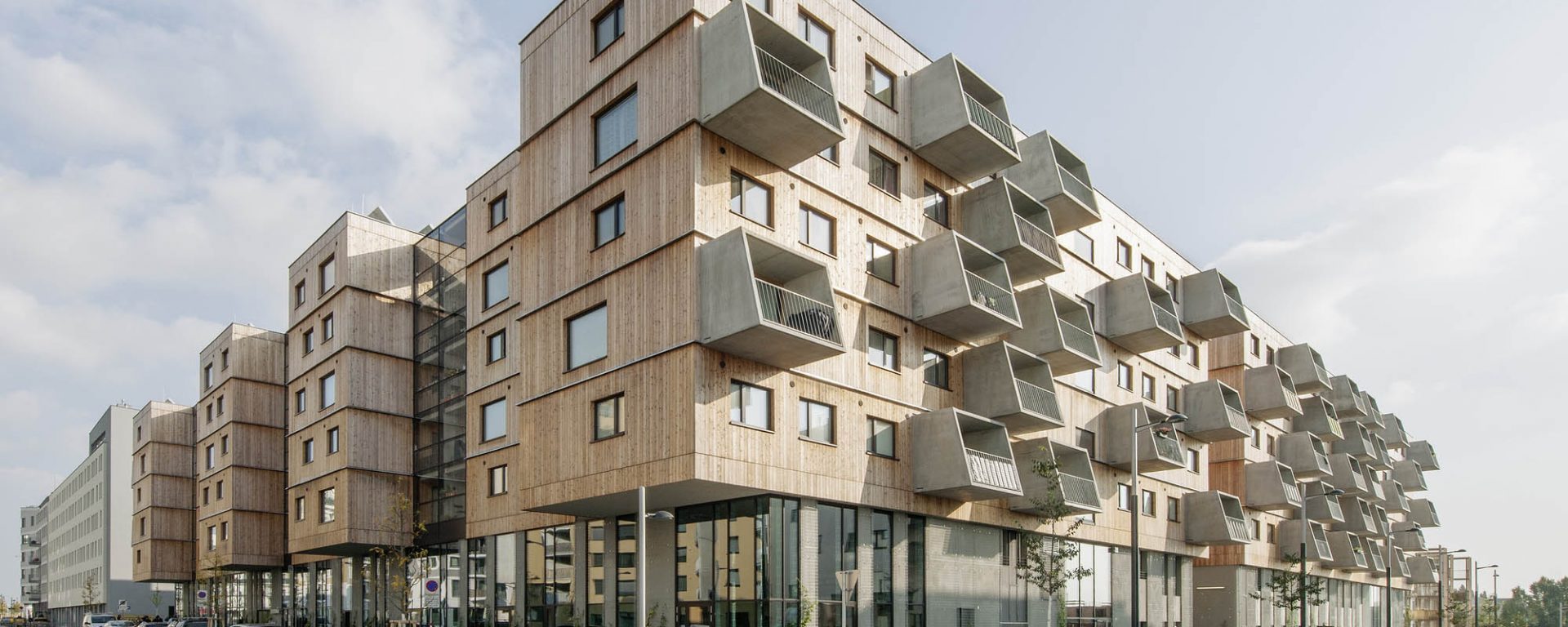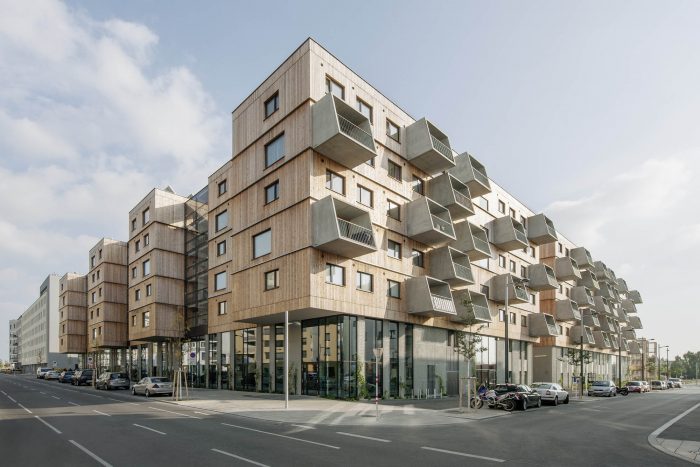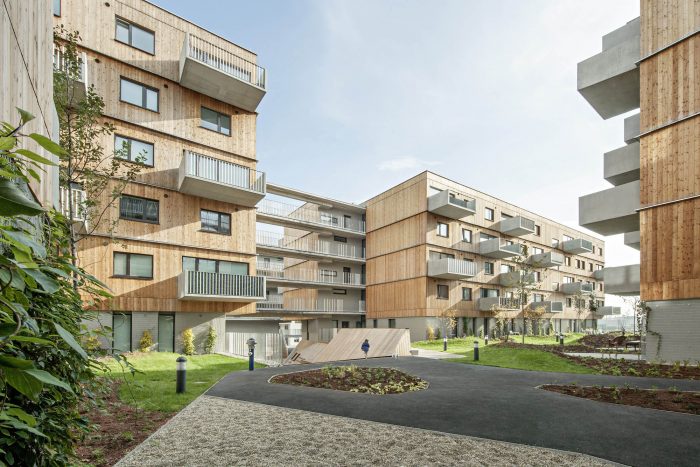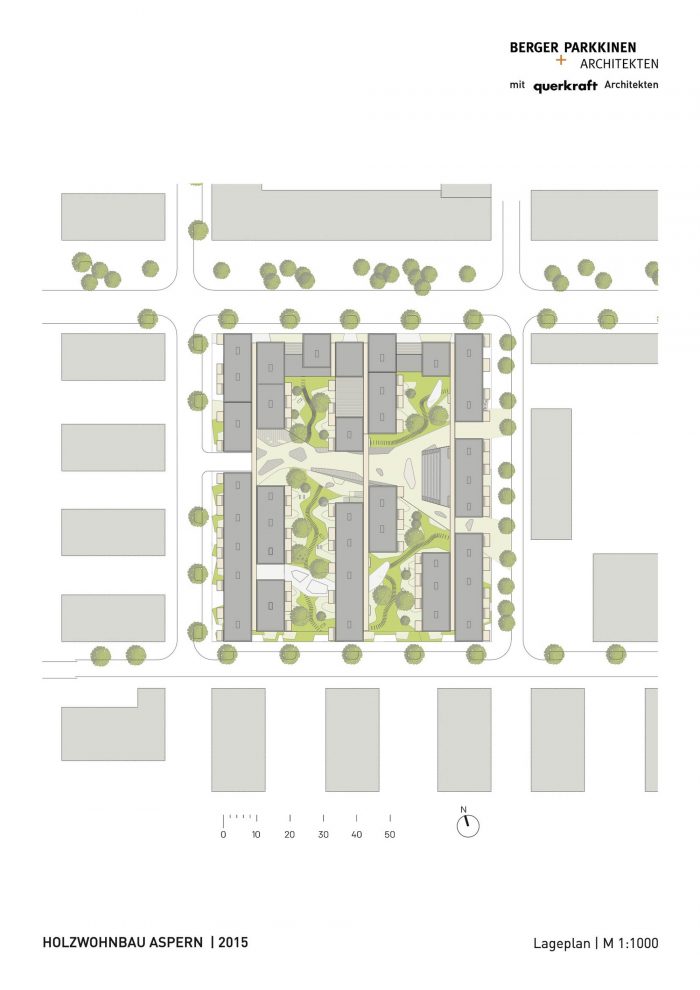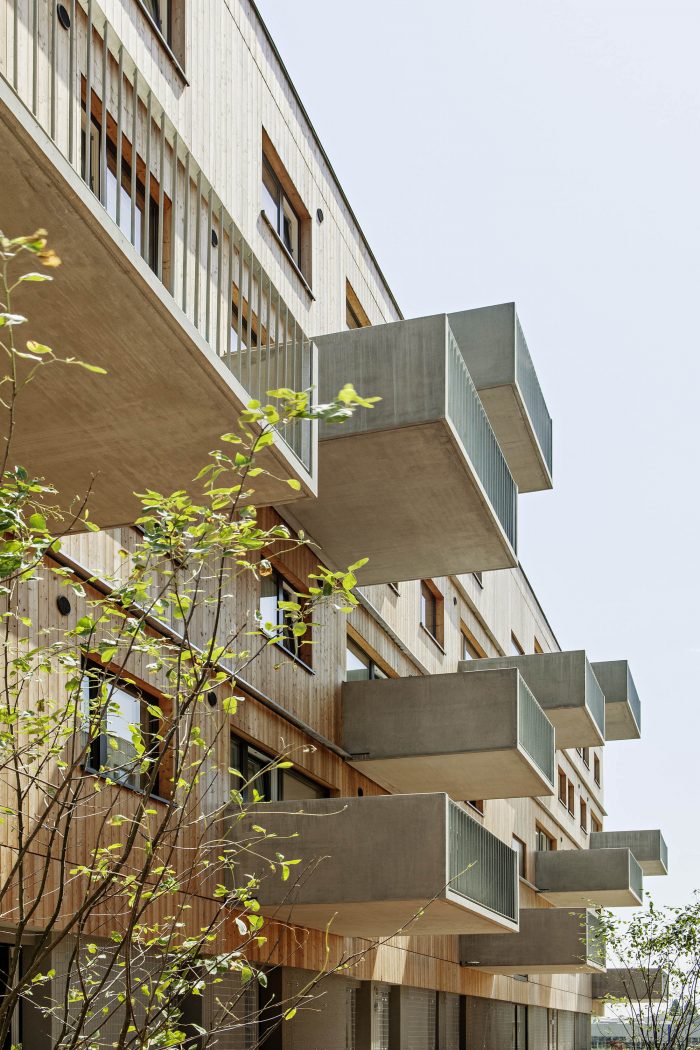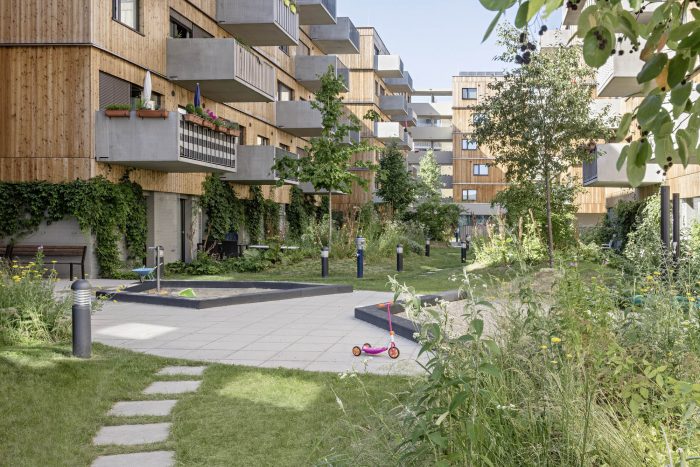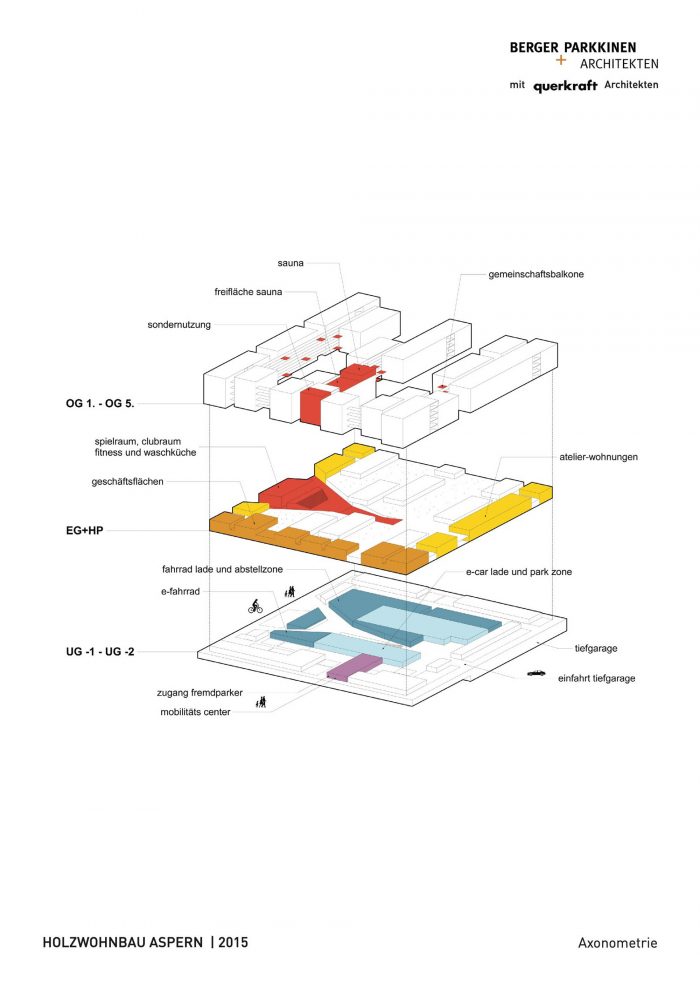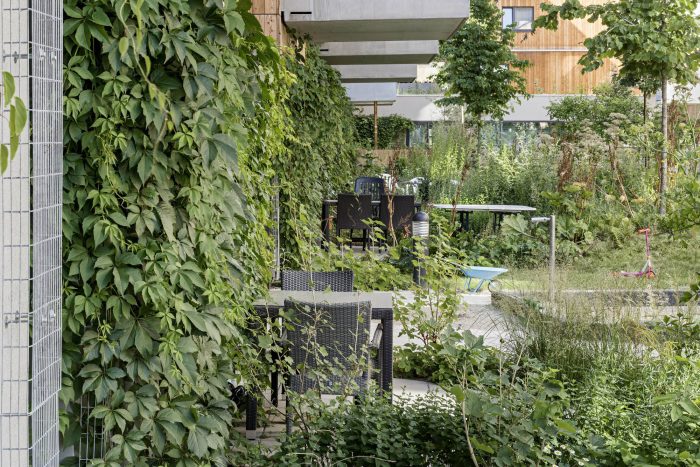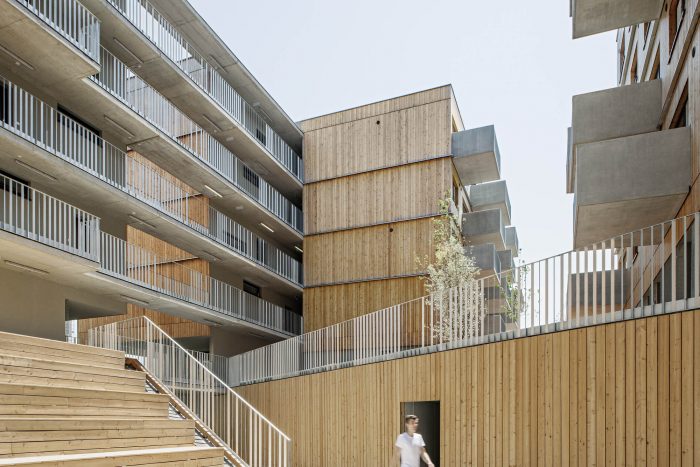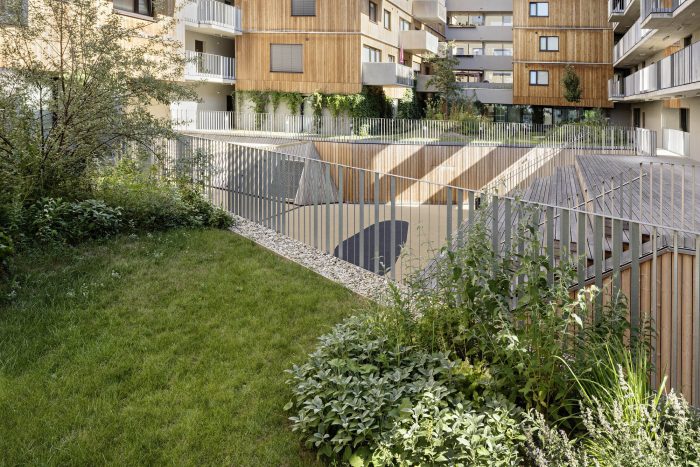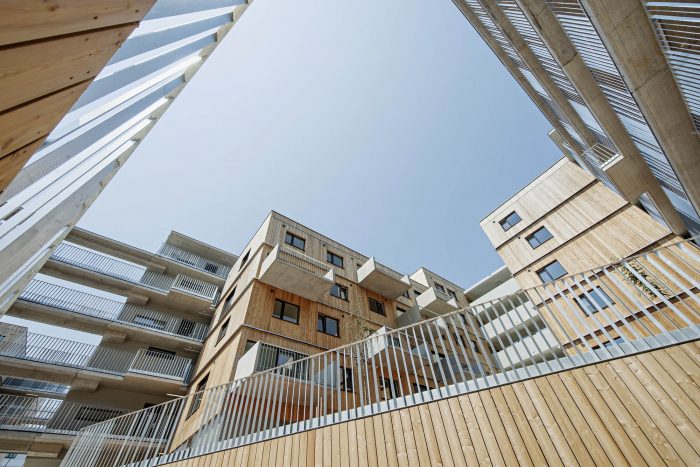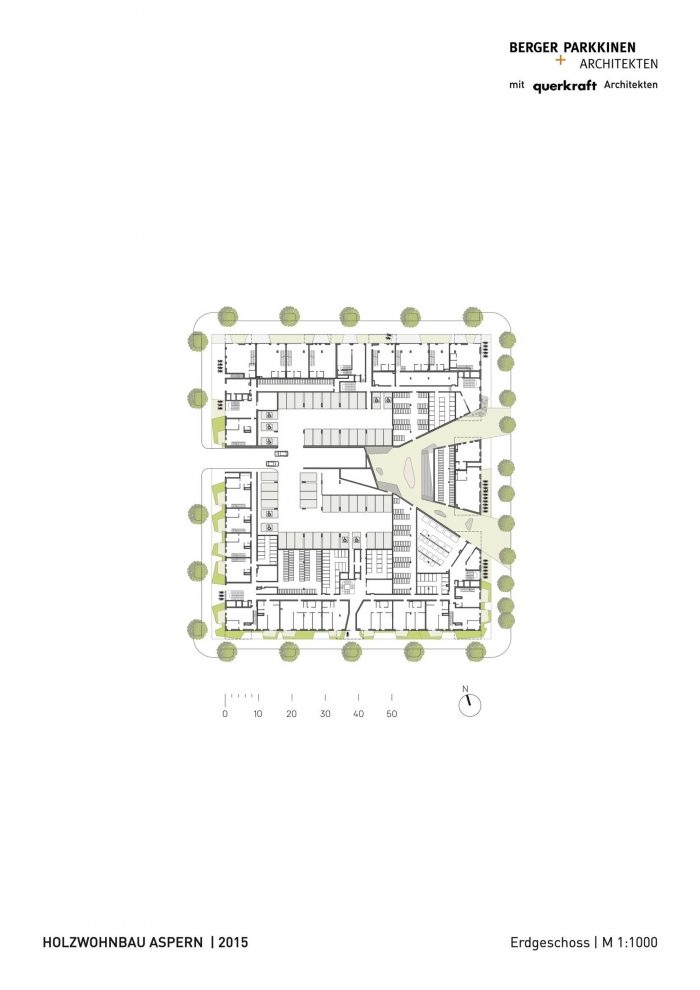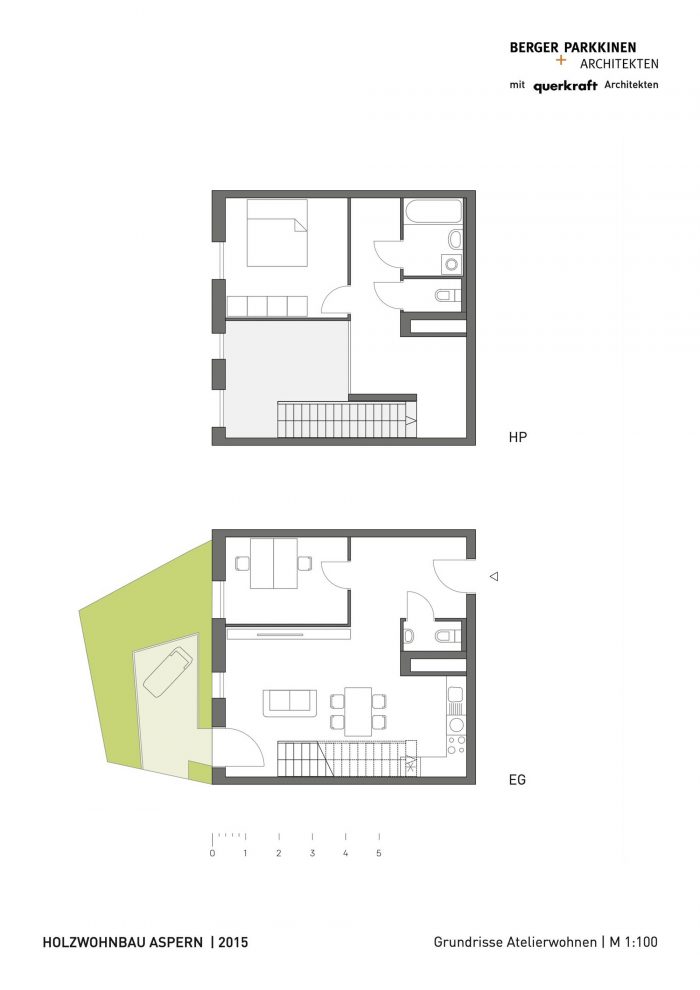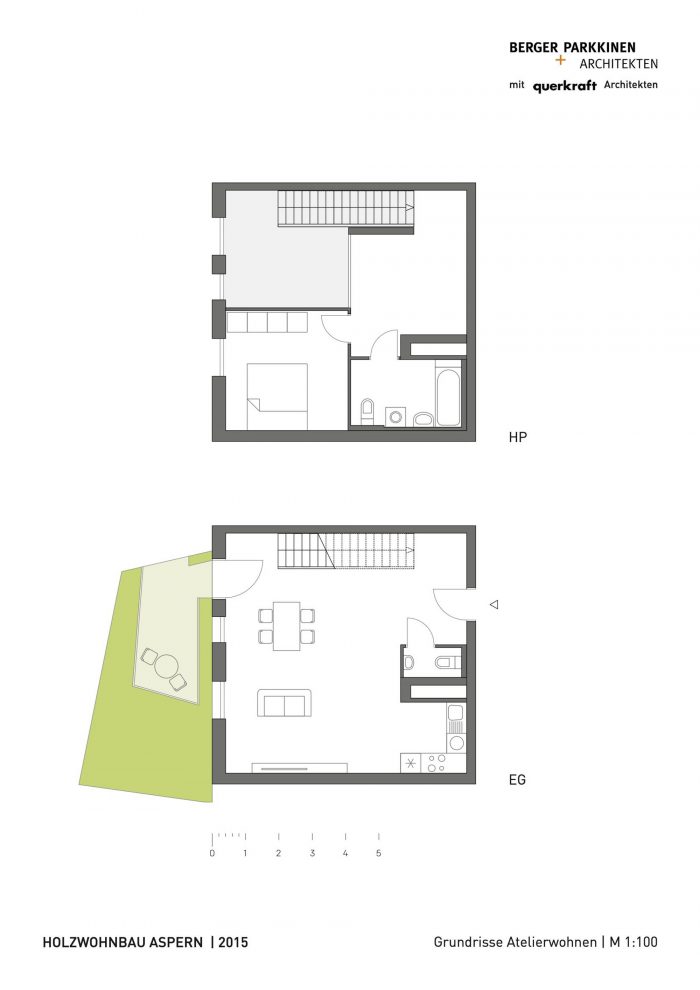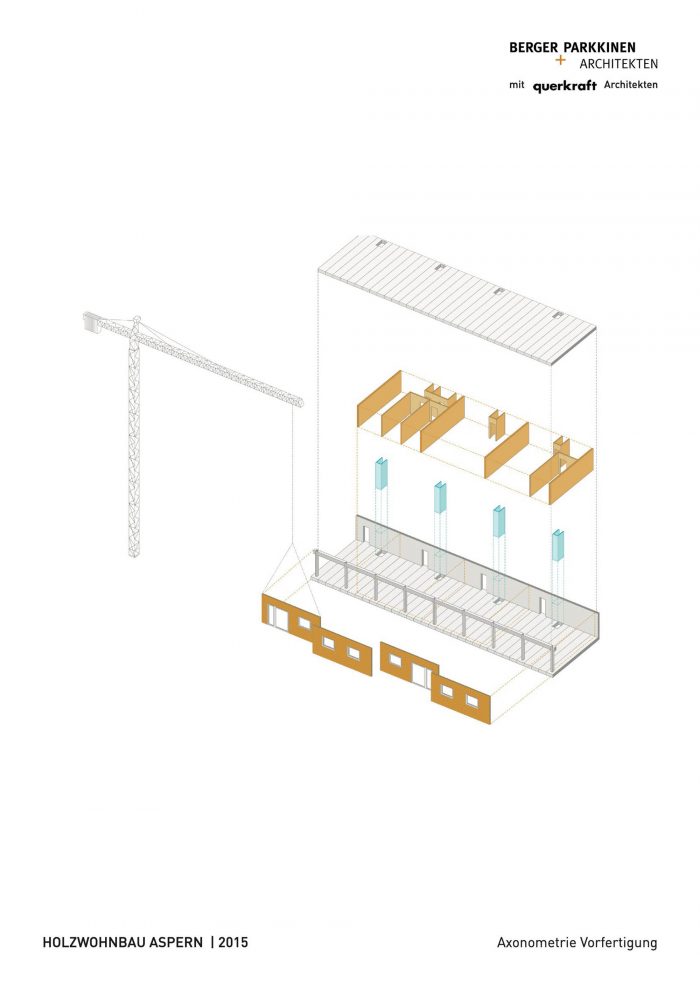一系列平行的建筑体量在规模上有所区别,利用了位于Seestadt Aspern东南部的大型建筑地块D12。该建筑群共有213套公寓和8个商店,显然是由一组清晰可辨的独立木制房屋组成,其形式为细长、紧凑的独立体量。错落有致的布局创造了不同类型的庭院式空间和各种视觉关系。
A sequence of parallel building volumes differentiated in terms of scale utilises the large building plot D12 in the south-eastern part of the Seestadt Aspern. The complex with a total of 213 apartments and eight shops apparently consists of a group of clearly recognisable individual timber houses in the form of slender, compact individual volumes. The staggered layout creates different kinds of courtyard-like spaces and a variety of visual relationships.
各个部分之间通过三排南北方向的通道平台相互连接。这三条循环路线通过一系列采光通风的楼梯、内部走廊和开放的通道平台,提供了不同的空间体验,公共平台就停靠在这些平台上。串行的线性基本结构为布置不同类型的公寓提供了极大的灵活性,因此允许居民的良好混合。公寓平面图的设计非常灵活。它们可以在以后以各种方式改变。尽管它们有一个很好的能源平衡,但建筑仍然向外开放。结合使用木材作为建筑材料,使整个建筑群既轻盈又有深度。
The various parts are connected to each other by three rows of access decks that run in a north-south direction. These three circulation routes offer a varied spatial experience provided by a sequence of light-flooded staircases, internal corridors and open access decks onto which communal terraces are docked. The serial, linear basic structure offers great flexibility in laying out very different types of apartments and consequently allows a good mix of residents. The apartment floor plans are conceived flexibly. They can be altered later in a variety of ways. Although they have an excellent energy balance the buildings still open generously to the outside. Combined with the use of timber as a construction material this gives the entire complex both lightness and depth.
衔接。住宅综合体被衔接成7个建筑部分,高度从地上4层到7层不等,还有一个地下车库。建筑体量的强烈衔接创造了一个生动的、朝南的开放空间,提供了多种空间关系。内院是一个半公共区域,形成了建筑群的共同心脏(峡谷),它与步行区相连,在底层被公共房间包围。
Articulation. The housing complex is articulated into seven building parts ranging in height from four to seven floors above ground level and an underground garage. The strong articulation of the building volumes creates a lively, south-facing open space that offers a variety of spatial relationships. The inner courtyard is a semi-public zone that forms the common heart (canyon) of the complex, which is connected to the pedestrian zone and is surrounded at the ground floor level by the communal rooms.
景观与空间。被称为峡谷的地方,是综合体中心的一个有几个层次变化和座位台阶的区域,为所有居民提供了一个在那里见面和体验社区的机会。它是一个邂逅空间,也是年轻人的游戏区。在一些地方,坡道墙壁上的木质覆层从墙壁中生长出来,形成倾斜的表面,供人们靠着或爬上去。大面积的水平面与墙体相连,形成可躺在上面或以不同方式使用的区域。
Landscape and Space. What is known as the canyon, an area with several changes of level and seating steps at the heart of the complex, offers all the residents an opportunity to meet there and experience community. It serves as an encounter space and a playing area for young people. At places, the wooden cladding lining the walls of the ramp grows out of the wall and forms sloping surfaces to lean against or clamber up. Large horizontal surfaces are connected with the wall and form areas to lie on or to use in different ways.
绿色的庭院与一些长满青草的小山丘一起,形成了一个有机的景观,这些小山丘带有翼状的梯田,故意向中央庭院的中间突出。山丘、树木和带小树冠的灌木遮挡了私人露台。通往丘陵景观的道路网络被刻意限制,以防止走廊式路线的发展。在入口区、洗衣房和儿童游乐场前的路口形成了聚会场所。
Together with a number of grassy hillocks the green courtyards with wing-shaped terraces that deliberately project into the middle of the central courtyard form an organic landscape. Hills, trees and shrubs with small crowns screen the private terraces. The network of paths leading through the hilly landscape is deliberately restricted to prevent the development of corridor-like routes. Meeting places are formed at junctions in front of entrance areas, laundries and the playground for small children.
立面的衔接在一些地方继续作为地面标示,在入口区域,它变得更加密集,用街道设施衔接商店和商业前的区域。这为前面的区域带来了活力,例如,为顾客提供户外座位。没有被围栏围住的高架灌木床与草坪条一起,在工作室公寓前形成了一个缓冲区。在这个缓冲区中开辟出大小适中的区域,以提供通道或创造消磨时间的空间。
The articulation of the façade is continued in places as ground marking, at the entrance areas it becomes denser and articulates the zone in front of the shops and businesses with street furniture. This introduces life to the front area with, for example, outdoor seating for customers. Raised beds of shrubs not enclosed by fences together with strips of lawn form a buffer in front of the studio apartments. Generously sized areas are cut out of this buffer to provide access or to create spaces in which to spend time.
结构和生态。高度隔热的外墙是由木头建造的。这些预制木墙是在工厂生产的,使用原生木材和以木头为基础的材料,并使用石棉作为绝缘材料,确保了高水准的质量。在外墙中,木材以落叶松木板的形式显现出来。墙体和内部隔墙也是在工厂生产的,它们是为了适应建筑服务而准备的。由于高水平的预制和快速的现场组装,对环境的影响以及噪音、灰尘和烟雾的数量都可以降到最低。
Structure and Ecology. The highly insulated external walls are built of wood. These prefabricated wooden walls are produced in the factory at an ensured high level of quality using native wood and wood-based materials, with stone wool as insulation. In the façades wood is evident in the form of larch boarding. The party walls and internal partition walls were also produced in the factory, where they were prepared to accommodate the building services. Thanks to the high level of prefabrication and speedy assembly on site the impact on the environment as well as the amount of noise, dust and fumes can be minimised.
混凝土框架允许自由设计外立面和永久灵活的平面图。所有的管道都集中在一个明确定义的辅助空间区域,旁边的循环。服务井的中心位置允许公寓类型在楼层与楼层之间相互映衬。外立面的外观由凸出的预制廊和阳台构成;外立面发展成一个自由发挥的游戏。
元素。始终如一地使用工业化预制建筑和建筑构件,提供了高质量的材料和表面,同时也使施工期极短。预制钢筋混凝土结构与木结构构件作为填充物的结合,将防火要求与经济的建筑方法相结合。
The concrete frame allows freedom in designing the façade and permanent flexibility in the floor plans. All the ducts are concentrated in a clearly defined zone of ancillary spaces beside the circulation. The central positioning of the services shaft allows the apartment types to be mirrored from floor to floor. The appearance of the façade is structured by projecting prefabricated loggias and balconies; the façade develops into a freely played game.
Elements. The consistent use of an industrially prefabricated building and construction elements offers materials and surfaces of high quality while also enabling the construction period to be kept extremely short. The combination of structural precast reinforced concrete with timber construction elements as infill combines the demands of fire protection with an economical building method.
建筑师:Berger+Parkkinen Architekten, Querkraft
面积:19600平方米
年份:2015年
照片:Hertha Hurnaus
客户:EBG, Vienna
Team Berger+Parkkinen Architekten: Lucas Schuh (Project Manger), Matthias Bachl, Jurgis Gecys, Jure Kozin, Marijana Vjesticová, Stefanie Sent
团队成员:Robert Haranza (Project Manager), Dominique Dinies, Georg Falkenhahn, Sandor Guba, Bernhard Mayer, Tim Stahlhut
景观 : idealice
结构顾问:Lackner + Raml Ziviltechniker-GmbH
建筑服务规划:TB Obkircher
建筑物理学: Holzforschung Austria
防火顾问: BrandRat ZT GmbH
木材结构:LC Buildings GmbH
雨水管理:ZT-Schattowitz
城市:维也纳
国家:奥地利
Architects: Berger+Parkkinen Architekten, Querkraft
Area: 19600 m²
Year: 2015
Photographs: Hertha Hurnaus
Client:EBG, Vienna
Team Berger+Parkkinen Architekten:Lucas Schuh (Project Manger), Matthias Bachl, Jurgis Gecys, Jure Kozin, Marijana Vjesticová, Stefanie Sent
Team Querkraft Architekten:Robert Haranza (Project Manager), Dominique Dinies, Georg Falkenhahn, Sandor Guba, Bernhard Mayer, Tim Stahlhut
Landscape:idealice
Structural Consultant:Lackner + Raml Ziviltechniker-GmbH
Building Services Planning:TB Obkircher
Construction Physics:Holzforschung Austria
Fire Protection Consultants:BrandRat ZT GmbH
Timber Structure:LC Buildings GmbH
Rainwater Management:ZT-Schattowitz
City:Vienna
Country:Austria

